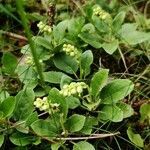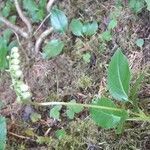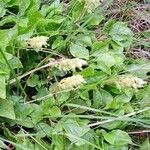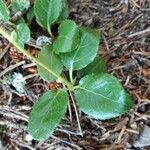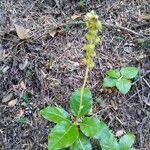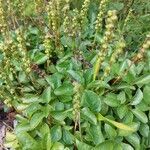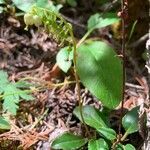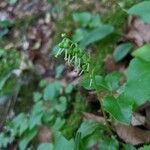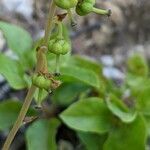Shrubs evergreen, herbaceous. Rhizome long creeping, slender, 0.5–1 mm in diam., woody, branched. Stems erect or ascending, 2–10 cm, 0.8–1.5 mm in diam., simple, angular, longitudinally minutely papillose. Leaves in 1–3 subverticils of 2–4 each, alternating with 5–7 scales; petiole 1–2 cm, minutely papillose; leaf blade pale green abaxially, light green adaxially, oblong-ovate to broadly ovate or elliptic, 2.2–3.7 × 1.4–2.6 cm, thinly leathery to herbaceous, abaxially glabrous, adaxially slightly shiny, base obtuse to truncate, margin crenulate-serru-late, apex acute to subobtuse or mucronulate. Scape 7–14 cm tall, slender, 0.4–1 mm in diam., loosely and minutely papillose, angled; scales 5–8 at middle and base, narrowly ovate or broadly lanceolate, 2–5 mm. Raceme with 8–15 rather densely arranged flowers along one side. Bracts broadly oblanceolate or broadly lanceolate, 3–5 mm, membranous, somewhat hyaline-margined, apex abruptly acute. Pedicel ca. 3 mm, slender, rather prominently papillose. Sepals overlapping at base, depressed-orbicular, 0.8–1 mm, margin minutely toothed, apex obtuse. Petals erect, greenish white, 3–5 mm. Anthers 1–1.5 mm, apex truncate; pores 0.3–0.4 mm wide. Style exserted, straight or slightly curved, ca. 4 mm; stigma peltate with 5 shallow lobes. Capsules 5-angular, ca. 4 mm in diam. Seeds with thin testa prolonged at both ends, fusiform to oblong; testa generally with 6–8 cells along longest axis. Fl. Jul–Aug, fr. Sep–Oct. 2n = 38.
More
Plants rhizomatous, 1.2-2.7 (-3.3) dm. Leaves: petiole 4-20 mm, channeled adaxially, glabrous; blade dull and light green abaxially, shiny and green adaxially, (10-)20-47(-58) × 7-28(-35) mm, base rounded to acute, apex rounded to acute. Inflorescences (2-)3-29-flowered; peduncle 10-20(-25) cm, peduncular bracts absent or 2-7, subulate to narrowly or broadly lanceolate, 3-9 × 1-2 mm, membranous, margins entire or erose-denticulate; inflorescence bracts subulate to lanceolate-ovate or narrowly ovate, ca. as long as pedicels they subtend, 4-9 × 0.4-1.8 mm, herbaceous. Pedicels (1-)3-7(-9) mm. Flowers: calyx lobes appressed or spreading in fruit, entirely green or margins hyaline to white or pinkish, 0.5-1.5 × 0.5-1.3 mm, margins erose-denticulate, sometimes obscurely so, apex rounded to obtuse; petals broadly ovate, 4.5-6 × 3-4 mm, margins erose-denticulate or irregularly toothed; stamens 4-8 mm; filament base 0.1-0.3 mm wide; anthers 1.2-1.8 mm, thecae tan or light brown, pores 0.2-0.5 × 0.2-0.4 mm; ovary smooth; style 3-5(-7) mm; stigma 1.4-2 mm wide. Capsules depressed-globose, 3-5 × 4-6 mm. 2n = 38.
A herb or small shrub. It keeps growing from year to year. The stems are creeping, slender and branched. The leaves are narrowly oval and 2-3 cm long by 1.5-2 mm wide. There are teeth along the edge. They are pale underneath. The fruit is a capsule about 5 mm wide.
